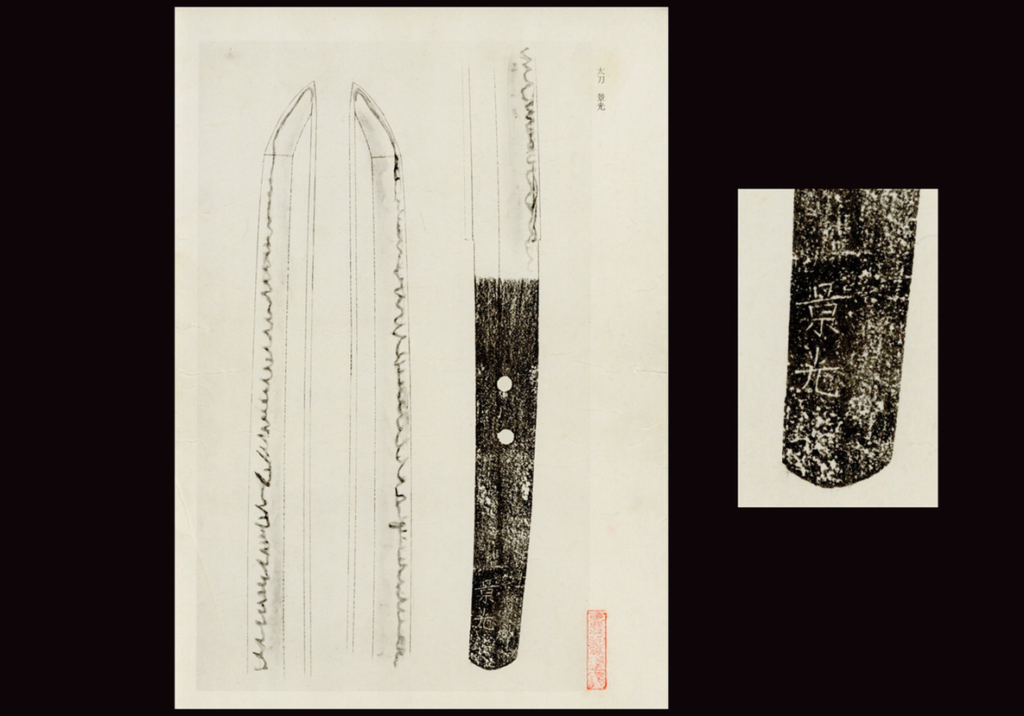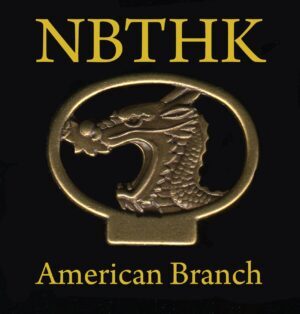
TACHI BY BIZEN OSAFUNE KAGEMITSU
備前長船景光
Bizen Kagemitsu (備前景光) was the son of Bizen Nagamitsu (備前長光) who was, in turn, the son of the founder of the Bizen Osafune School, Mitsutada (備前光忠). The works by these first three generations of smiths solidified the foundation of the Osafune School into one of the greatest schools of sword making of all time.
Bizen Kagemitsu (備前景光) is called Sahyôhenjô in most accounts and his dated works show that he was born in the latter part of the 13th century. We have works from him dating from the Kagen era (嘉元 – 1303) through the Kenmu era (建武 – 1335). While his father and teacher, Nagamitsu (長光), did not leave many tantô; Kagemitsu, (景光) on the other hand, has left us a great number of fine tantô that have survived through the years. He also made extraordinary tachi and katana.
There exists one tachi and one tantô that have been designated to be National Treasures (Kokuhô), and twelve tachi and one tantô that have been classified as Important Cultural Properties (Jûyô Bunkazai). Finally there are ten tachi, two katana, and eight tantô that are designated to be Important Art Objects (Jûyô Bijitsuhin). This is a very impressive list, indeed.
Among the very few extant examples of tantô by Nagamitsu (長光) there are some that do exhibit gunome (互の目) patterns very close to the kataochi gunome (片落ち互の目) (saw tooth) type. While this shows that Nagamitsu (長光) may have been the first smith to begin using a form of this kataochi gunome (片落ち互の目) pattern of hamon, it was his son, Kagemitsu (景光) who made this type of temper the trademark of most of his tantô.
His katana and tachi will generally also possess some kataochi gunome (片落ち互の目) mixed in with patterns of regular gunome, chôji, notare, etc.
Kagemitsu (景光) was an important link in the succession of great smiths from the Osafune School (長船). We know he was the son of Nagamitsu (長光), but he was also the older brother and teacher of Kagemasa (景政). We know that there was a close relationship between these two smiths because of the fact that the works of Kagemasa (景政) closely resemble those of Kagemitsu (景光) especially in the slight bit of ashi that appears in the suguha of both smiths.
Another important contemporary of Kagemitsu (景光) was Chikakage (近景). We know of the relationship between these two smiths for many reasons. First both were contemporary in time and both were students of Nagamitsu (長光). Also during the later period of Kagemitsu’s (景光) life, we find swords with an unusual signature, i.e. signed with the chisel cuts done in a reverse manner (saka-tagane). It is known that Chikakage (近景) cut this type of signature in works he substitute-signed for Kagemitsu (景光). Such a situation would only occur where there was a close working relationship.
Kagemitsu (景光) also passed along his legacy to his son, Kanemitsu (兼光) who became known as O Kanemitsu (大兼光). Kanemitsu (兼光) worked well into the Nanbokuchô era. Kanemitsu (兼光) went on to lead the Osafune School (長船) and influenced such well-known smiths as Tomomitsu (倫光), Yoshimitsu (義光), Hidemitsu (秀光), Motomitsu (基光), Masamitsu (政光), and Shigemitsu (重光).
Sugata: In tachi, the sugata exhibits the features characteristic of the Kamakura era. Generally blades are shinogi-zukuri, iori mune with koshi-zori. His long blades that are not suriage (shortened), with have funbari. The literal meaning of funbari is “spreading of the legs” or “standing firmly and with ones legs apart”. In other words, there is a marked tapering over the first 4-5 cm from a wide machi. There will be hira-niku and the kasane is made thick. The appearance of the blade will be one of grace and elegance.
Tantô will also be in a shape typical of the Kamakura era. They will be hira-zukuri with a narrow mihaba. They will exhibit uchi-zori with an iori mune.
Jitetsu: The kitae is ko-itame mixed with small mokume, making a fine and beautiful grain. The ji-nie is also fine and the midare-utsuri or choji-utsuri will appear in a pronounced manner. Occasionally one with bo-utsuri will be found which is perhaps a forerunner of the bo-utsuri found in Bizen works of the Muromachi Era.
Hamon: The hamon will be nioi-based, as is the case with Bizen works. Kagemitsu’s hamon will resemble that of his father, Nagamitsu, having a mixture of various kinds of choji mixed with occasional gunome. Occasionally a suguha hamon will be found. In Kagemitsu’s hamon, however, the gunome will have flatter heads and will lean toward one side like the teeth of a saw blade. This is called kataochi gunome (片落ち互の目) and it is a famous trademark of this smith, especially in his tanto. In his long tantô, kataochi gunome (片落ち互の目) will be found running the length of the blade. In his long swords, it will be found in conjunction with normal gunome, chôji, notare, etc.
Bôshi: The bôshi of Kagemitsu is also an important kantei point. In most cases (there are always exceptions), his tachi were known for what is called the “san-saku bôshi”. This bôshi is called a san-saku bôshi since three swordsmiths, Nagamitsu, Kagemitsu, and Sanenaga made it. The characteristics of this type of bôshi are that it is fairly straight when crossing the yokote and then it slightly undulates in the mid point ending in a maru shape with kaeri.
His tanto will have a more pointed bôshi with a slight kaeri.
Horimono: Most of Kagemitsu’s works will have intricately made carvings of a variety of subjects. Kenmakui Ryu, Suken, Dokko Tsuki Ken, Tsume Tsuki Ken, Bonji, are found. Bo-hi are seen with the tops of the hi being pointed in nature.
Nakago: Not many ubu blades tachi exist, but in general the nakago will be made with the tip in ha-agari-kurijiri. The yasurime will be kiri, katte-sagari, or sujikai. The shape of the nakago of the tantô will be typical of the Kamakura era without too much sori or in furisode shape. Rarely the mei will be given in two characters. Most will be a naga-mei.
Kantei points: His jigane will be fine and densely forged in ko-itame with some mokume, a bluish tint, and plentiful ji-nie. This points to the Osafune group of smiths and particularly to Kagemitsu. His blades will have a san-saku bôshi and his hamon will have kataochi-gunome (片落ち互の目). His tantô will be entirely of kataochi-gunome (片落ち互の目) whereas those of his father, Nagamitsu, may contain some kataochi-gunome (片落ち互の目).
This tachi is an exceptional example of the work of Kagemitsu. It is wider than most examples and while it has been shortened somewhat, it still retains most of its original sori and excellent length of over 72 cm or about 28.5 inches. Also it is signed with his rarely used ni-ji mei (two character signature). The jitetsu (grain of the steel) of this blade has profuse utsuri and chikei on both sides and shows the epitome of this sword maker’s abilities. The chôji-midare temper line has a wide nioiguchi that is mixed with gunome containing many saka-ashi and some kinsuji.
This blade was awarded the prestigious rank of Jûyô Tôken (Important Sword) in 1970. In 1982 it was selected by Dr. Honma to be included in a special exhibition of excellent and important swords held in Tôkyô (catalog pictured below) on November 7, 1982 by the Kunzan sensei ni manabukai.
Below is a translation of the Jûyô Tôken zufu that describes this superb sword:
Jūyō-tōken at the 19th jūyō shinsa from June 1, 1970
Tachi, mei: Kagemitsu (景光)
Measurements
Nagasa 72.4 cm, sori 1.5 cm, motohaba 2.9 cm, sakihaba 2.0 cm, kissaki-nagasa 3.15 cm, nakago-nagasa
18.3 cm, nakago-sori 0.2 cm
Description
Keijō: shinogi-zukuri, iori-mune, suriage, shallow sori, somewhat elongated chū-kissaki
Kitae: rather standing-out itame that is partially mixed with rougher hada and that features all over chikei and a midare-utsuri
Hamon: chōji-midare in ko-nie-deki with a wide nioiguchi that is mixed with gunome, many saka- ashi, and a few kinsuji
Bōshi: gently undulating notare-komi with a ko-maru-kaeri
Nakago: suriage, kurijiri, sujikai-yasurime, two mekugi-ana, the haki-omote side bears at the tip of the tang and towards the nakago-mune a niji-mei
Explanation
Although suriage, this is a tachi by Bizen Osafune Kagemitsu(景光) that retains its niji-mei
(two-character signature).
Kagemitsu(景光)was the son of Nagamitsu(⻑光)and the third generation of the Osafune main line and he was as skilled as his father and grandfather.
The hardening in chōji here is mixed with gunome that tends to kataochi and the jigane is excellent. Like seen with his father Nagamitsu, the bōshi is notare-komi with a brief ko-maru-kaeri. Kagemitsu only rarely signed in niji-mei and most of his signatures are naga-mei, with some of them containing the prefix Sahyōhen Jō
(左兵衛尉).
This sword comes in an old shirasaya with a sayagaki by the former head of the NBTHK and famous sword expert, Junji Honma. The sayagaki says the following:
備州⻑船景光
⼆字銘珍之
磨上刄⻑⼆尺三⼨⼋分余
昭和⼰⾣年晩秋
依重⽥五郎⽒之嘱
薫⼭誌「花押」
Bishū Osafune Kagemitsu
Niji-mei mezurashii kore.
Suriage hachō ni-shaku san-sun hachi-bu yo.
Shōwa tsuchinoto-toridoshi banshū.
Shigeta Gorō-shi no tanomi ni yotte.
Kunzan shirusu + kaō
Osafune Kagemitsu from Bizen Province
Signed in niji-mei, which is rare.
Shortened, blade length ~ 72.2 cm.
Late fall on the year of the rooster of the Shōwa era (1969).
Written by Kunzan [Honma Junji] on request of Mr. Shigeta Gorō + monogram
